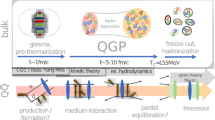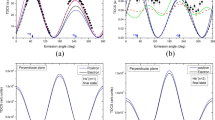Summary
We analyse the complications appearing in the description of multiparticle production due to the quantum statistics, interference and resonance production, in a stochastic-approximation scheme which is not based on a particular dynamical model. The scheme is based on the cluster expansion of the final-state density matrix. It shows how the clustering phenomena may be related to the established features of strong interactions, in particular to resonances, and also provides a natural mechanism for the long-range correlations. The presented scheme offers more insight into the theoretical background of the standard statistical models of particle production processes.
Riassunto
Si analizzano le complicazioni che compaiono nella descrizione della produzione multiparticellare dovuta alla statistica quantica, all’interferenza e alla produzione di risonanze, in uno schema di approssimazione stocastica che non è basato su un particolare modello dinamico. Lo schema si basa sulla espansione ad ammasso della matrice di densità dello stato finale. Esso mostra come i fenomeni di ammasso possano essere messi in relazione con gli aspetti stabiliti delle interazioni forti, in particolare con le risonanze, e fornisce anche un meccanismo naturale per le correlazioni a lungo raggio. Lo schema presentato fornisce anche un migliore esame del substrato teorico dei modelli statistici standard dei processi di produzione multiparticellari.
Реэюме
Мы аналиэируем усложнения, воэникаюшие при описании множественного рождения частиц, обусловленные квантовой статистикой, интерференционным и реэонансым рождением, в схеме стохастического приближения, которая не основана на специальной динамической модели. Предложенная схема основана на кластерном раэложении матрицы плотности конечного состояния. Покаэывается, как явление обраэования кластеров может быть свяэано с установленными особенностями сильных вэаимодействий, в частности, с реэонансами, а также дает естественный механиэм для длиннодействуюших корреляций. Предложенная схема поэволяет понять теоретическуо основу стандартных статистических моделей процессов рождения частиц.
Similar content being viewed by others
References
A. Arneodo andG. Plaut:Nucl. Phys.,107 B, 262 (1976).
E. L. Berger, R. Singer, G. H. Thomas andT. Kafka:Phys. Rev. D,15, 206 (1977).
P. Grassberger:Nucl. Phys.,120 B, 231 (1977).
B. Y. Oh, W. Morris, D. L. Parker, G. A. Smith, J. Whitmore, R. J. Miller, J. J. Phelan, P. F. Schultz, L. Voyvodic, R. Walker, R. Yaari, E. W. Anderson, H. B. Crawley, W. J. Kernan, P. Ogino, R. G. Glasser, D. G. Hill, G. McLennan, H. L. Price, B. Sechi-Zorn, G. A. Snow andF. Svrcek:Phys. Lett.,56 B, 400 (1975).
T. Kafka, R. Engelman, R. Godbole, J. Hanlon, M. Pratap, H. Wahl, R. Singer, Y. Cho, T. H. Fields, L. G. Hyman, L. Voyvodic, R. Walker andJ. Whitmore:One-, two-, and three-particle distributions in ppcollisions at 205 GeV/c, Argonne preprint ANL-HEP-PR-76-79.
J. Karczmarczuk:Random phase approximation scheme in multiparticle production processes, Bielefeld preprint BI-TP 76/29.
Y. W. Lee:Statistical Theory of Communication (New York, N. Y., 1960).
T. E. O. Ericson andT. Mayer-Kuckuk:Ann. Rev. Nucl. Sci.,16, 183 (1966).
R. Klauder andE. C. G. Sudarshan:Fundamentals of Quantum Optics (New York, N. Y., 1968).
H. M. Fried:Functional Methods and Models in Quantum Field Theory (Cambridge, Mass., 1972).
G. E. Brown:Many-Body Problems (Amsterdam, 1972).
I. Montvay andH. Satz:Nuovo Cimento,39 A, 425 (1977).
G. Goldhaber, S. Goldhaber, W. Lee andA. Pais:Phys. Rev.,120, 300 (1960).
G. I. Kopylov:Interference of interacting identical mesons, Dubna preprint, P2-10092 (1976).
R. Hanbury Brown andR. Q. Twiss:Proc. Roy. Soc.,243 A, 291 (1957).
M. Deutschmann, R. Honecker, H. Kirk, M. Klein, R. Nahnhauer, R. Hartmann, H. Plothow, V. T. Cocconi, M. J. Counihan, S. Humble, G. Kellner, D. R. O. Morrison, P. Schmid, R. Stroynowski, L. Aniola, T. Coghen, K. Dziunikowska, J. Figiel, A. Zalewska, E. Leitner, J. Stieve, J. Krolikowski, A. Para andA. K. Wroblewski:Nucl. Phys.,103 B, 198 (1976).
C. Ezell, L. J. Gutay, A. T. Laasanen, F. T. Dao, P. Schubelin andF. Turkot:Phys. Rev. Lett.,38, 873 (1977).
A. Krzywicki:Clustering and clusters, CNRS (Orsay) preprint, LPTPE-76/25.
F. A. Berezin:The Method of Second Quantization (New York, N. Y., 1966).
Author information
Authors and Affiliations
Rights and permissions
About this article
Cite this article
Karczmarczuk, J. Quantum cluster decomposition of the hadronic final state and stochastic theory of multiple hadron production. Nuov Cim A 43, 557–574 (1978). https://doi.org/10.1007/BF02730344
Received:
Published:
Issue Date:
DOI: https://doi.org/10.1007/BF02730344




